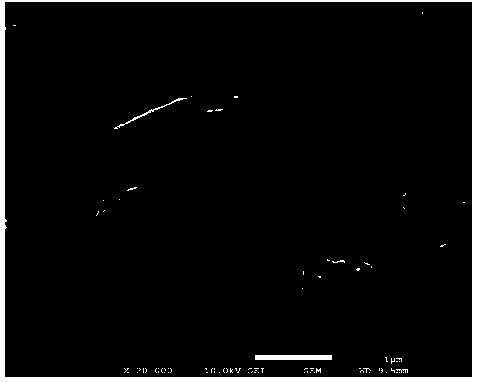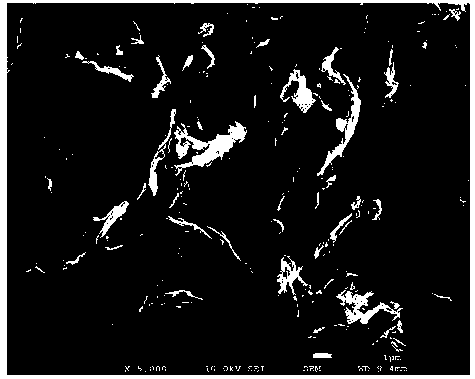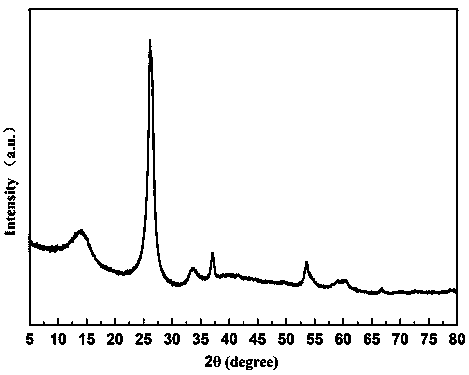Molybdenum disulfide/graphene composite material and preparation method and application thereof
A technology of molybdenum disulfide and composite materials, applied in secondary batteries, electrochemical generators, electrical components, etc., can solve the problems of molybdenum disulfide composite materials such as complex process, low cycle efficiency, and poor stability, and achieve excellent cycle stability Good reproducibility and repeatability, the effect of inhibiting agglomeration
- Summary
- Abstract
- Description
- Claims
- Application Information
AI Technical Summary
Problems solved by technology
Method used
Image
Examples
Embodiment 1
[0039] S1. Preparation of ammonium tetrathiomolybdate: Dissolve 5 g of ammonium molybdate tetrahydrate in 30 mL of deionized water, adjust the pH to 11 with ammonia water, add 70 mL of ammonium sulfide solution, stir and reflux at 80°C for 2.5 h, cool to room temperature , standing for crystallization for 42h, the crystallization was filtered, washed with absolute ethanol, and dried at room temperature for 24h to obtain ammonium tetrathiomolybdate crystals.
[0040] S2. Preparation of graphene slurry by electrochemical method: using graphite rod as working electrode, N-butylpyridinium tetrafluoroborate and 1-hexyl-3-methylimidazolium hexafluorophosphate at a volume ratio of 1:1 The mixture was used as an electrolyte, electrolyzed at a voltage of 8.5V for 18h, and then subjected to solid-liquid separation, ultrasonic dispersion, and washing to obtain a graphene slurry with a mass concentration of 1.5%.
[0041]S3. Graphene surface modification: Accurately weigh 3.644g (0.01mol)...
Embodiment 2
[0047] S1. Preparation of ammonium tetrathiomolybdate: Dissolve 5 g of ammonium molybdate tetrahydrate in 30 mL of deionized water, adjust the pH to 12 with ammonia water, add 90 mL of ammonium sulfide solution, stir and reflux at 90°C for 1.5 h, cool to room temperature , standing for crystallization for 36h, the crystallization was filtered, washed with absolute ethanol, and dried at room temperature for 24h to obtain ammonium tetrathiomolybdate crystals.
[0048] S2. Preparation of graphene slurry by electrochemical method: using graphite rod as working electrode, N-butylpyridinium tetrafluoroborate and 1-octyl-3-methylimidazolium bromide with a volume ratio of 1:1:1 The mixture of salt and 1-hexyl-3-methylimidazolium hexafluorophosphate was used as the electrolyte, electrolyzed at a voltage of 7V for 24h, and then subjected to solid-liquid separation, ultrasonic dispersion, and washing, and finally obtained graphene with a mass concentration of 2.0%. slurry.
[0049] S3. ...
Embodiment 3
[0053] S1. Preparation of ammonium tetrathiomolybdate: Dissolve 5 g of ammonium molybdate tetrahydrate in 30 mL of deionized water, adjust the pH to 9.5 with ammonia water, add 85 mL of ammonium sulfide solution, stir and reflux at 85°C for 2 h, cool to room temperature, Stand for crystallization for 30 hours, filter the crystals, wash with absolute ethanol, and dry at room temperature for 24 hours to obtain ammonium tetrathiomolybdate crystals.
[0054] S2. Preparation of graphene slurry by electrochemical method: using graphite rod as working electrode, N-butylpyridine tetrafluoroborate and 1-octyl-3-methylimidazolium bromide with a volume ratio of 1:1 The mixture was used as an electrolyte, electrolyzed at a voltage of 6V for 36h, and then subjected to solid-liquid separation, ultrasonic dispersion, and washing to obtain a graphene slurry with a mass concentration of 2.5%.
[0055] S3. Graphene surface modification: Accurately weigh 3.644g (0.01mol) of hexadecyltrimethylamm...
PUM
 Login to View More
Login to View More Abstract
Description
Claims
Application Information
 Login to View More
Login to View More - R&D
- Intellectual Property
- Life Sciences
- Materials
- Tech Scout
- Unparalleled Data Quality
- Higher Quality Content
- 60% Fewer Hallucinations
Browse by: Latest US Patents, China's latest patents, Technical Efficacy Thesaurus, Application Domain, Technology Topic, Popular Technical Reports.
© 2025 PatSnap. All rights reserved.Legal|Privacy policy|Modern Slavery Act Transparency Statement|Sitemap|About US| Contact US: help@patsnap.com



